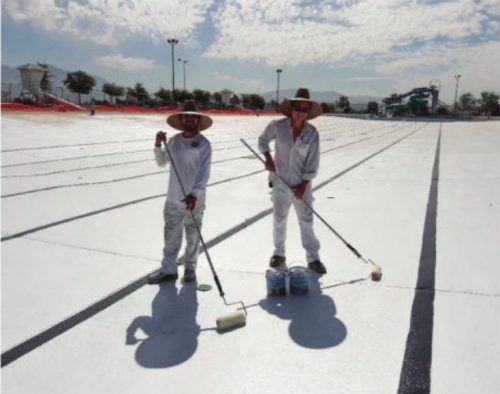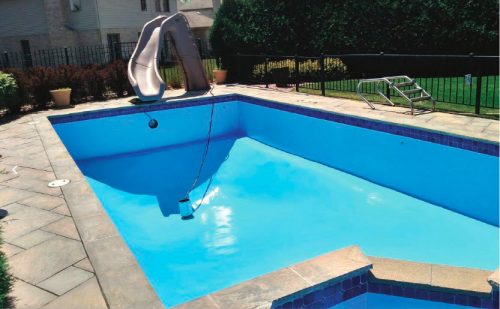Inspect and prepare the pool surface

Once one has determined the best type of paint to use on the pool, the next step is to carefully inspect the pool surface and repair any minor damage. To do this properly, the following steps must be taken:
- Drain the pool and allow it to dry.
- Clear away any debris left on the bottom.
- Visually inspect the empty pool, scanning for peeling paint, cracks, chips, or surface defects.
- Scrape any peeling, flaking, or chipped paint and sand smooth.
- Repair any minor cracks or chips. A structural engineer should be consulted if any major cracks or surface defects are found. These areas should be thoroughly investigated as they may compromise the integrity of the pool.
Preparing the surface before beginning to paint is very important.
“We sand or water blast the surface so we can get to bare concrete before painting,” says Lenz. “After water blasting, it is important not to paint too soon because moisture can remain on the surface and prevent the paint from going on smoothly.”
Clean the surface
The pool surface must be completely clean and free of loose paint, dirt, oils, or solutions before applying a new coating system. There are products designed specifically for pool surface preparation, and using them is highly recommended. In most cases, these products can reduce the amount of time needed to clean the pool’s surface, allowing the job to be completed with just one step in one-third the amount of time.

Pool professionals who are not using a specialty ‘clean and prep’ product should use the following three-step process:
- Power wash the entire pool surface using a minimum 22,063-kPa (3200-psi) power washer.
- Once dry, sweep or use a blower to clear away any leftover paint chips or debris.
- Use a garden sprayer to evenly apply a preparation product to the entire surface, following the manufacturer’s mixing instructions.
- Scrub the solution, which will begin to foam and etch. Continue scrubbing until the foaming stops, paying extra attention to areas where heavy soil accumulates, such as the waterline and steps.
- Flush the surface three times with a strong stream of clean water from a garden hose. Do not flush using a power washer as it lacks the volume of water required to effectively flush the surface. It is important that all residual preparation solutions are removed.
Pro tip: A clean, bare concrete or plaster surface that is ready for painting should have the texture of medium-grade sandpaper.
“We like to clean the surface with trisodium phosphate as it has a detergent that neutralizes the acids that remain on the pool surface from previous painting or cleaning,” says Lenz.
Outdoor pools that are not covered during the winter accumulate all types of fall foliage and debris, which can affect the painted surface. Unfortunately, sometimes industry standard cleanup procedures can adversely affect the success of painting a pool.
“In the past, we would acid wash pools to clean up the debris before we opened them for the summer,” says Lenz. “However, we discovered the acid wash not only removes the leaves and organic debris, but also often strips away layers of paint.”
According to Lenz, this is one of the reasons his company recommends homeowners put a safety cover on outdoor pools—not just for safety, but also for preserving the painted surface over the winter.
Pro tip: Always wear rubber gloves and protective eyewear when handling chemicals and paints. Pool professionals should always follow all safety precautions on power equipment being used, too.
Let the surface dry
The type of coating being applied will dictate how dry the surface must be before the process can begin. Acrylic paint can be applied to a damp surface; however, it must be completely dry when using epoxy paint. In any case, a pool professional should check the instructions on the product label to determine the dryness requirements. Moisture may still be present even if a surface looks and feels dry; therefore, pool professionals should use the following steps to test for dryness:
- Use duct tape to affix 0.6-m2 (2-sf) sheets of clear plastic to three different areas of the pool—one to the floor in the shallow end, another to the floor in the deep end, and the third on a wall in the deep end that receives shade.
- After the plastic sheets have been applied, wait four to five hours.
- After the waiting period check inside the plastic for any signs of moisture from condensation.
- If moisture is present, remove all three areas of plastic and let the surface dry for another 24 hours. Then, repeat the test.
Applying the paint

When applying the pool coating, it is important to adhere to the recommended coverage. Paint that is applied too thin will not provide adequate coverage or yield a long-lasting result; whereas a thick coat may cause air bubbles, ‘alligatoring,’ or blistering.
Pro tip: Pool professionals should avoid painting if the temperature is below 10 C (50 F), above 29.4 C (85 F), or if the overnight temperature will drop below 10 C (50 F). If the temperature is above 29.4 C (85 F), the paint can blister. Temperatures under 10 C (50 F) will cause the paint formula to become more ‘viscous’ or thickened, making it difficult to apply the coat evenly.
A water-based paint will be susceptible to freezing, which can change the formula properties. Pool paints are designed to dry and cure within a defined temperature range. The chemicals that make up the paint require the proper temperature to bond together and adhere to the surface. If the paint is not able to cure, uneven coverage, peeling, bubbling, cracking, and other problems can occur.
In addition, do not paint in direct sunlight as it will affect adhesion, primarily because it causes the paint to dry too quickly. The solvents in the formula will not be able to evaporate properly and result in adhesion failure. High temperatures can cause the paint to bubble and blister, which results in peeling once it cures.
To apply pool paint correctly, it is important to use these best practices from the field:
- Sweep or use a leaf blower to clear away any remaining leaves, paint chips, or debris before starting to paint.
- Use masking tape to protect any areas that are not to be painted (e.g. tiles or fittings). To avoid getting paint on larger areas, cover them with plastic and tape.
- Paint around small or hard-to-reach areas (e.g. drain openings, corners, and ladders) using a paintbrush.
- Use a roller to paint larger areas, beginning with the walls.
- Once the walls are complete, move to the floor and start at the deepest section.
- Always paint toward the shallow end, and plan to finish at a ladder or stairs to exit the pool without stepping on the wet paint.
- Refer to the product recommendations to determine if a second coat is necessary. If so, allow for the proper drying time as per the product’s instructions. Then, follow the same application steps.
“The ‘time’ between coats of paint can get tricky on pools that are outdoors—especially if it rains between coats of paint,” says Lenz. “Rain can really slow down the process as the painting of the second coat typically needs to happen within eight to 48 hours.
“In our experience, once you get beyond the 48-hour mark, the second coat won’t bond to the first. When this happens, you need to roughen the surface of the first coat to get the second coat to stick. We end up having to do this manually to get the second coat to adhere, which is terribly time consuming.”
Pro tip: If rain interrupts the pool painting progress, a good rule of thumb is to add one day for the surface to dry for each day of rain.







Terrific article- good reminders and tips. Much appreciated!
Such a great blog.
http://flosil-bet.com/